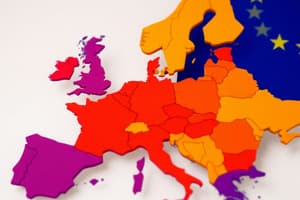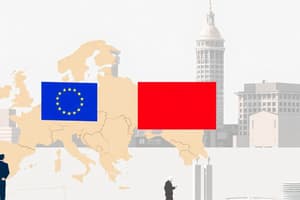Podcast
Questions and Answers
A country eliminates tariffs with fellow members but maintains individual tariffs for non-members. Which stage of economic integration does this describe?
A country eliminates tariffs with fellow members but maintains individual tariffs for non-members. Which stage of economic integration does this describe?
- Economic and Monetary Union
- Customs Union
- Single Market
- Free Trade Area (correct)
Which of the following best exemplifies the principle of supremacy as established by EU law?
Which of the following best exemplifies the principle of supremacy as established by EU law?
- A national court hears a case regarding the application of an EU directive on worker's rights.
- A German importer is permitted to sell French liquor in Germany, despite it not meeting German national standards.
- A member state's environmental law is superseded by EU environmental regulations in cases of conflict. (correct)
- Member states harmonize their economic policies to facilitate the introduction of a common currency.
Which measure describes the removal of physical, fiscal, and technical barriers to trade, such as tariffs, within an economic union?
Which measure describes the removal of physical, fiscal, and technical barriers to trade, such as tariffs, within an economic union?
- Positive Integration
- Negative Integration (correct)
- Fiscal Harmonization
- Monetary Policy Coordination
Following the Cassis de Dijon ruling, a country must allow the sale of a product legally sold in another member state, even if it doesn't fully comply with its own regulations. What concept does this illustrate?
Following the Cassis de Dijon ruling, a country must allow the sale of a product legally sold in another member state, even if it doesn't fully comply with its own regulations. What concept does this illustrate?
Which of the following initiatives is most closely associated with the Delors Commission?
Which of the following initiatives is most closely associated with the Delors Commission?
According to the principle of mutual recognition, what condition allows a member state to reject a product legally sold in another member state?
According to the principle of mutual recognition, what condition allows a member state to reject a product legally sold in another member state?
Which event marked the beginning of the path to the euro?
Which event marked the beginning of the path to the euro?
During the 'Snake in the Tunnel' arrangement, what were European currencies pegged to?
During the 'Snake in the Tunnel' arrangement, what were European currencies pegged to?
What was the primary goal of the Stability and Growth Pact (SGP) agreed upon in 1997?
What was the primary goal of the Stability and Growth Pact (SGP) agreed upon in 1997?
Which of the following is NOT a Maastricht convergence criterion that member states had to meet to join the EMU?
Which of the following is NOT a Maastricht convergence criterion that member states had to meet to join the EMU?
What is the 'no bailout clause' within the context of the Eurozone designed to prevent?
What is the 'no bailout clause' within the context of the Eurozone designed to prevent?
According to the theory of Optimum Currency Area (OCA), what is a critical requirement for countries to share a single currency effectively?
According to the theory of Optimum Currency Area (OCA), what is a critical requirement for countries to share a single currency effectively?
What was the alleged political motivation behind the Maastricht plan, especially concerning Germany?
What was the alleged political motivation behind the Maastricht plan, especially concerning Germany?
In a currency union, when devaluation is not an option, what are the alternative mechanisms that member states (MS) can employ to manage economic differences?
In a currency union, when devaluation is not an option, what are the alternative mechanisms that member states (MS) can employ to manage economic differences?
Which of the following characteristics is NOT a primary requirement for an Optimal Currency Area (OCA)?
Which of the following characteristics is NOT a primary requirement for an Optimal Currency Area (OCA)?
How does fiscal federalism function within a currency union?
How does fiscal federalism function within a currency union?
What is the primary purpose of establishing a banking union within a currency union such as the Eurozone?
What is the primary purpose of establishing a banking union within a currency union such as the Eurozone?
Which of the following is an example of the EU's regulatory powers?
Which of the following is an example of the EU's regulatory powers?
How do the EU's redistributive powers contribute to economic balance among member states?
How do the EU's redistributive powers contribute to economic balance among member states?
What was the main goal of the Stability and Growth Pact's (SGP) stricter rules implemented after the Eurozone crisis?
What was the main goal of the Stability and Growth Pact's (SGP) stricter rules implemented after the Eurozone crisis?
Flashcards
Free Trade Area (FTA)
Free Trade Area (FTA)
Tariffs are eliminated between member countries, but each maintains its own tariffs for non-members.
Customs Union
Customs Union
Eliminates internal tariffs and establishes a common external tariff for non-member countries.
Single Market
Single Market
Free movement of goods, services, capital, and labor between member states.
Direct Effect
Direct Effect
Signup and view all the flashcards
Supremacy of EU Law
Supremacy of EU Law
Signup and view all the flashcards
High Factor Mobility
High Factor Mobility
Signup and view all the flashcards
Similar Economic Structure
Similar Economic Structure
Signup and view all the flashcards
Fiscal Federalism
Fiscal Federalism
Signup and view all the flashcards
Banking Union
Banking Union
Signup and view all the flashcards
EU's Regulatory Powers
EU's Regulatory Powers
Signup and view all the flashcards
EU's Redistributive Powers
EU's Redistributive Powers
Signup and view all the flashcards
EFSF
EFSF
Signup and view all the flashcards
Mutual Recognition Principle
Mutual Recognition Principle
Signup and view all the flashcards
Bretton Woods System
Bretton Woods System
Signup and view all the flashcards
"Snake in the Tunnel/Outside the Tunnel"
"Snake in the Tunnel/Outside the Tunnel"
Signup and view all the flashcards
European Currency Unit (ECU)
European Currency Unit (ECU)
Signup and view all the flashcards
Maastricht Convergence Criteria
Maastricht Convergence Criteria
Signup and view all the flashcards
Stability and Growth Pact (SGP)
Stability and Growth Pact (SGP)
Signup and view all the flashcards
Optimum Currency Area (OCA)
Optimum Currency Area (OCA)
Signup and view all the flashcards
Factor Mobility
Factor Mobility
Signup and view all the flashcards
Study Notes
- Economic integration evolves over time through increased cooperation.
Stages of Economic Integration
- Free Trade Area (FTA) eliminates tariffs between members, but each country maintains its own tariffs for non-members.
- Customs Union eliminates internal tariffs and establishes a common external tariff.
- Single Market allows free movement of goods, services, capital, and labor.
- Economic and Monetary Union (EMU) harmonizes economic and monetary policies among members.
- Political Union entails a common government with integrated economic and political decision-making.
The Single Market
- Treaty of Rome (1957): Initiated to seek closer European union, targeting a customs union and eventually a single market.
- Single European Act (1986): Aimed to establish the single market by 1992.
- Four Freedoms: Encompass the free movement of goods, services, capital, and people.
- 1985 Delors Commission: oversaw the creation of the internal market.
- 1988 Cecchini Report: Assessed the costs and benefits of the EU common market.
Integration Measures
- Negative integration: Aims at eliminating physical, fiscal, and technical trade barriers.
- Positive integration: Establishes common standards, like social and environmental norms.
- Brussels Effect: EU regulations often become global standards due to the EU's market size.
Key Rulings for EU Law
- Van Gend en Loos (1963): Established the principle of direct effect, allowing individuals to enforce EU law in national courts.
- Costa v. ENEL (1964): Introduced the principle of supremacy, prioritizing EU law over national law.
- Cassis de Dijon (1979): Introduced the principle of mutual recognition, mandating that products legally sold in one member state must be accepted in others, barring certain exceptions.
The Eurosystem
- Path to the euro: Began with fixing exchange rates.
- Bretton Woods system: Maintained fixed exchange rates until 1973.
- Snake in the tunnel: Currencies were pegged to each other and the dollar.
- Snake outside the tunnel: Currencies were pegged to each other with fluctuation margin of Å}2.25%.
- European Currency Unit (ECU): Introduced as a banking currency.
Three Stages of EMU
- 1990-1993: Ensured free capital movement, economic policy coordination, and cooperation between central banks.
- 1994-1998: Convergence occurs with Maastricht criteria compliance (inflation, public debt, budget deficit, interest rates, exchange rate stability).
- Since 1999: Establishment of the European Central Bank (ECB), fixed exchange rates, and the introduction of the Euro.
- Maastricht plan: Used to contain Germany after the Cold War and German reunification.
Maastricht Convergence Criteria
- To join the EMU member states, strict economic criteria had to be met.
- Stability and Growth Pact (SGP) of 1997: Designed to ensure members maintain fiscal discipline post-Euro adoption.
- SGP involves multilateral budgetary surveillance and a deficit limit through the excessive deficit procedure (EDP).
- There were financial penalties for countries with excessive deficits.
- Each government is responsible for its own debt (no bailout clause)
Theory: Optimum Currency Area (OCA)
- Optimum Currency Area (OCA): An area economically linked by trade in goods, services and factor mobility (capital/labour)
- Member States should only share a single currency if they can assist each other during economic hardship.
- In a currency union, devaluing the currency is impossible, so MS need other ways to handle economic differences.
- An OCA requires high factor mobility
- Similar Economic structure required
- OCA requires Fiscal federalism
Banking Union
- Unified banking system where bank regulation and supervision are centralized at a eurozone level.
EU's Economic Leverages
- Regulatory Powers: Establishing market standards, antitrust regulations, merger controls etc.
- Redistributive powers: Through cohesion, agricultural, and structural funds.
- Expenditure Powers: EU budget funded by VAT, customs duties, and national contributions.
- Eurozone Crisis: Started in Greece (2009)
- New Institutions Created: European Financial Stability Facility (EFSF) and European Stability Mechanism (ESM) Changes made to rules of Stability and Growth Pact (Fiscal Compact)
Stricter rules in the SGP
- Deficit and Debt was important.
- Enhanced role was given to the Commission in monitoring public finances.
- Banking Union: Strengthened regulation of the banking sector by placing Eurozone banks under ECB supervision.
Corona Rescue Package (Next Generation EU)
- Stimulus package of €750 billion, divided between loans and grants to recover the economy post-COVID-19
- Joint borrowing by the EU member states through issued bonds.
- Money used to focus on digitalization and green innovations.
The Next Turn in the Single Market
- EU will become the first climate-neutral continent by 2050.
- 2030 target: Reduce greenhouse gas emissions by at least 55% compared to 1990 levels.
- Political opposition has lead to rebranding the effort
- Digital Single Market: Focus on digitalization of the single market to maintain global competitiveness.
- Post-COVID rescue fund supports digital, innovative, and green businesses.
Studying That Suits You
Use AI to generate personalized quizzes and flashcards to suit your learning preferences.
Related Documents
Description
Explore economic integration stages: Free Trade Area, Customs Union, Single Market, EMU, and Political Union. Focus on the Single Market's establishment through the Treaty of Rome and the Single European Act. Learn about the four freedoms.




